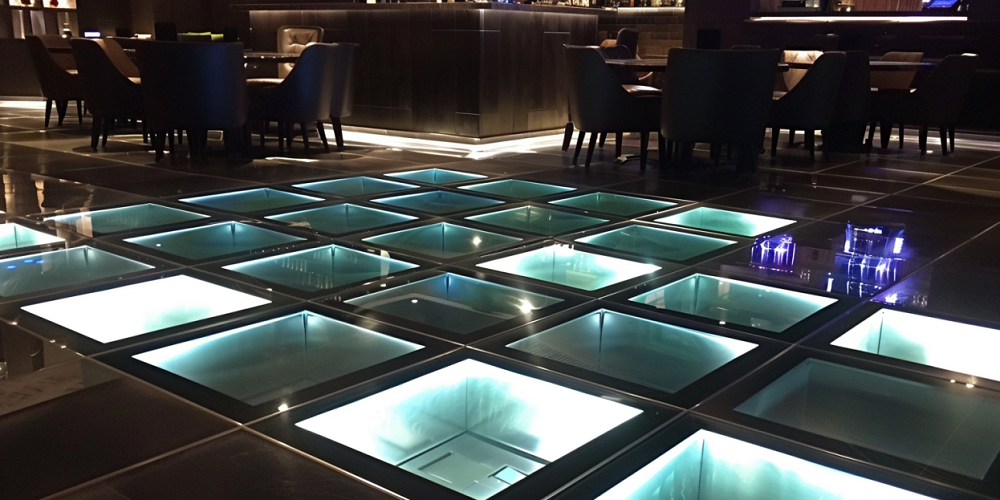Casinos are more than just hubs for gaming – they are empires of sensory experience, designed to immerse visitors in an atmosphere of thrill and anticipation. Among the myriad of carefully curated details, the flooring plays an unexpectedly pivotal role. Far from being merely a surface to walk on, casino flooring serves as both a psychological stimulant and a practical necessity. Let’s dive into the types of flooring that best suit the unique needs of a casino setting.

The Strategic Design of Casino Flooring
Casino flooring is much more than a surface to walk on; it’s a crucial component of the casino’s psychological and aesthetic appeal. The bold patterns and vibrant colors are not selected haphazardly; they play a subtle yet pivotal role in enhancing the gaming experience. Intricate carpet designs, for example, often feature elements associated with luck and prosperity, which may subconsciously entice patrons to continue playing in hopes of a big win.
But the design’s complexity isn’t solely for psychological effect; it serves a practical function as well. High-traffic areas benefit from the busy patterns that effectively camouflage spills, stains, and dropped items, reducing the need for constant cleaning and allowing the casino to maintain an immaculate appearance with less effort.
Top 10 Best Casino Flooring Ideas
When choosing the best flooring for a casino, several factors need to be considered, including durability, ease of maintenance, aesthetic appeal, and the psychological impact on patrons. Here are some of the top flooring options that are commonly used in casino environments:
1. Raised Access Flooring with Custom Finishes
Pros: It hides cables and infrastructure, provides easy access for repairs, and can be topped with a range of finishes to match the casino’s style. Huiya offers a top-quality access floor for Casions at a budget-friendly cost.
Cons: Installation can be more complex and costly than other flooring types.
2. Patterned Carpet
Pros: Carpets with complex, colorful patterns are excellent for hiding stains and wear. They can also be customized with intricate designs that contribute to the casino’s thematic elements.
Cons: Requires regular cleaning and maintenance to keep it looking fresh.
3. Luxury Vinyl Tile (LVT)
Pros: Offers the appearance of natural stone or hardwood but with greater durability and less maintenance. It’s also more comfortable underfoot than traditional tile.
Cons: Can be more expensive than some other options.
4. Porcelain Tile
Pros: Extremely durable and able to withstand high traffic. Available in various designs, porcelain tiles can mimic the look of natural stone or wood.
Cons: Harder surface may be less comfortable for standing patrons over long periods.
5. Epoxy Flooring
Pros: Offers high durability and can be customized with colors and patterns. It is seamless, making it easy to clean and resistant to stains.
Cons: Can be slippery when wet, although anti-slip coatings can mitigate this.
6. Terrazzo
Pros: Highly durable and aesthetically pleasing, terrazzo allows for a high level of customization with various materials and colors.
Cons: Can be one of the more expensive flooring options and requires professional installation.
7. Natural Stone
Pros: Marble, granite, and other natural stones offer a luxurious and high-end look. They are also very durable.
Cons: Natural stone can be costly and requires regular maintenance to prevent stains.
8. Engineered Wood
Pros: Provides the warm appearance of wood with better resistance to moisture and temperature changes than solid hardwood.
Cons: Can be damaged under the extremely high traffic of a casino and may not be as long-lasting as other options.
9. Stained Concrete
Pros: Incredibly durable and can be stained or textured for a unique look. It is also low maintenance and can handle heavy foot traffic.
Cons: May require rugs or mats in areas where patrons stand for extended periods due to its hardness.
10. Broadloom Carpet
Pros: Offers a more traditional look and can be less expensive than carpet tiles while still providing comfort and noise reduction.
Cons: May show seams over time and is less versatile than carpet tiles for pattern customization.
The selection of the best flooring for a casino depends on the specific needs and design vision of the establishment. A combination of these materials might be used in different areas of the casino to optimize both function and style. For instance, high-traffic areas might benefit from LVT or porcelain tile for durability, whereas carpet may be preferred in gaming areas for its sound-absorbing qualities and the psychological comfort it provides to patrons.
